This is an old revision of this page, as edited by RegentsPark (talk | contribs) at 02:11, 31 October 2008 (Last good version). The present address (URL) is a permanent link to this revision, which may differ significantly from the current revision.
Revision as of 02:11, 31 October 2008 by RegentsPark (talk | contribs) (Last good version)(diff) ← Previous revision | Latest revision (diff) | Newer revision → (diff) For the Red Panda, see Red Panda.
| Giant Panda | |
|---|---|

| |
| Panda at National Zoo in Washington, D.C. | |
| Conservation status | |
 Endangered (IUCN 3.1) | |
| Scientific classification | |
| Kingdom: | Animalia |
| Phylum: | Chordata |
| Class: | Mammalia |
| Order: | Carnivora |
| Family: | Ursidae |
| Genus: | Ailuropoda |
| Species: | A. melanoleuca |
| Binomial name | |
| Ailuropoda melanoleuca (David, 1869) | |
| Subspecies | |

| |
| Giant Panda range | |
The Giant Panda (Ailuropoda melanoleuca, literally "cat-foot black-and-white") is a mammal classified in the bear family (Ursidae), native to central-western and southwestern China. The Giant Panda was previously thought to be a member of the Procyonidae family (raccoons and their relatives). It is easily recognized by its large, distinctive black patches around the eyes, over the ears, and across its round body. Though belonging to the order Carnivora, the Giant Panda has a diet which is 99% bamboo. The Giant Panda may eat other foods such as honey, eggs, fish, yams, shrub leaves, oranges, and bananas when available.
The Giant Panda lives in a few mountain ranges in central China, in Sichuan, Shaanxi, and Gansu provinces. It once lived in lowland areas, but farming, forest clearing, and other development now restrict the Giant Panda to the mountains.
The Giant Panda is an endangered species and highly threatened. According to the latest report, China has 239 Giant Pandas in captivity and another 27 living outside the country. It also estimated that around 1,590 pandas are currently living in the wild. However, a 2006 study, via DNA analysis, estimated that there might be as many as 2,000 to 3,000 Giant Pandas in the wild. Though reports show that the numbers of wild pandas are on the rise, the International Union for Conservation of Nature believes there is not enough certainty to remove the Giant Panda from the endangered animal list.
While the dragon has historically served as China's national emblem, in recent decades the Giant Panda has also served as an emblem for the country. Its image appears on a large number of modern Chinese commemorative silver, gold, and platinum coins. The species is a favorite of the public, at least in part because many people find that it has a baby-like cuteness. Also, it is usually depicted reclining peacefully eating bamboo, as opposed to hunting, which adds to its image of innocence. Though the Giant Panda is often assumed to be docile, it has been known to attack humans, presumably out of irritation rather than predatory behavior.
Appearances
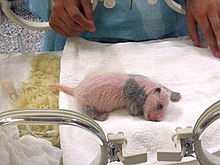
The Giant Panda has a black-and-white coat. Adults measure around 1.5 m long and around 75 cm tall, at the shoulder. Males are 10-20% larger than females. Males can weigh up to 115 kg (253 pounds). Females are generally smaller than males, and can occasionally weigh up to 100 kg (220 pounds). The Giant Panda lives in mountainous regions, such as Sichuan, Gansu, Shaanxi, and Tibet.
The Giant Panda has a body shape typical of bears. It has black fur on its ears, eye patches, muzzle, legs, and shoulders. The rest of the animal's coat is white. Although scientists do not know why these unusual bears are black and white, some speculate that the bold coloring provides effective camouflage into its shade-dappled snowy and rocky surroundings. The Giant Panda's thick, wooly coat keeps it warm in the cool forests of its habitat. The Giant Panda has large molar teeth and strong jaw muscles for crushing tough bamboo.
The Giant Panda has a paw, with a "thumb" and five fingers; the "thumb" is actually a modified sesamoid bone, which helps the Giant Panda to hold bamboo while eating. Stephen Jay Gould used this example in his book of essays concerned with evolution and biology, The Panda's Thumb.
The Giant Panda has the second longest tail in the bear family, with one that is 4-6 inches long. The longest belongs to the Sloth Bear.
The Giant Panda can usually live to be 20-30 years old in captivity.
Behavior
In the wild, the Giant Panda is a terrestrial animal and primarily spends its life roaming and feeding in the bamboo forests of the Qinling Mountains and in the hilly Sichuan Province. Though generally alone, each adult has a defined territory and females are not tolerant of other females in their range. Pandas communicate through vocalization and scent marking such as clawing trees or spraying urine. It is able to climb and take shelter in hollow trees or rock crevices but does not establish permanent dens. As such pandas do not hibernate, which is similar to other subtropical mammals, and will instead move to elevations with warmer temperatures. Pandas rely primarily on spatial memory rather than visual memory.
Social encounters primarily occur during the brief breeding season in which pandas in proximity to one another will gather. After mating, the male leaves the female and the mother is alone to raise the cub.
Diet
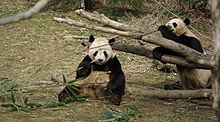
Despite its taxonomic classification as a carnivore, the Giant Panda has a diet that is primarily herbivorous, which consists almost exclusively of bamboo. However, the Giant Panda still has the digestive system of a carnivore and does not have the ability to digest cellulose efficiently, and thus derives little energy and little protein from consumption of bamboo. The average Giant Panda eats as much as 9 to 14 kg (20 to 30 pounds) of bamboo shoots a day. Because the Giant Panda consumes a diet low in nutrition, it is important that it keep its digestive tract full. The limited energy input imposed on it by its diet has affected the panda's behavior. The Giant Panda tends to limit its social interactions and avoids steeply sloping terrain in order to limit its energy expenditures.
Two of the panda's most distinctive features, its large size and its round face, are adaptations to its bamboo diet. Panda researcher Russell Ciochon observed that: “uch like the vegetarian gorilla, the low body surface area to body volume is indicative of a lower metabolic rate. This lower metabolic rate and a more sedentary lifestyle allow the giant panda to subsist on nutrient poor resources such as bamboo.” Similarly, the Giant Panda's round face is the result of powerful jaw muscles, which attach from the top of the head to the jaw. Large molars crush and grind fibrous plant material.
Twenty-five species of bamboo are eaten by pandas in the wild, such as Fargesia dracocephala and Fargesia rufa. Only a few bamboo species are widespread at the high altitudes pandas now inhabit. Bamboo leaves contain the highest protein levels; stems have less.
Because of the synchronous flowering, death, and regeneration of all bamboo within a species, the Giant Panda must have at least two different species available in its range to avoid starvation. While primarily herbivorous, the Giant Panda still retains decidedly ursine teeth, and will eat meat, fish, and eggs when available. In captivity, zoos typically maintain the Giant Panda's bamboo diet, though some will provide specially formulated biscuits or other dietary supplements.
Classification
For many decades the precise taxonomic classification of the Giant Panda was under debate as both it and the distantly related Red Panda share characteristics of both bears and raccoons. However, molecular studies suggest that the Giant Panda is a true bear and part of the Ursidae family, though it differentiated early in history from the main ursine stock. The Giant Panda's closest ursine relative is the Spectacled Bear of South America. Disagreement still remains about whether or not the Red Panda belongs in Ursidae, the raccoon family Procyonidae, or in its own family, Ailuridae. The Giant Panda has been referred to as a living fossil.
The Red Panda and the Giant Panda, although completely different in appearance, share several features. They both live in the same habitat, they both live on a similar bamboo diet, and they both share a unique enlarged bone called the pseudo thumb, which allows them to grip the bamboo shoots they eat.
Subspecies
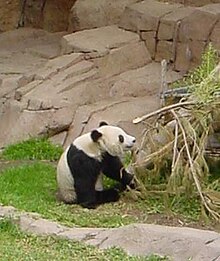
Two subspecies of Giant Panda have been recognized on the basis of distinct cranial measurements, color patterns, and population genetics (Wan et al., 2005).
- The nominate subspecies Ailuropoda melanoleuca melanoleuca consists of most extant populations of panda. These animals are principally found in Sichuan and display the typical stark black and white contrasting colors.
- The Qinling Panda, Ailuropoda melanoleuca qinlingensis is restricted to the Qinling Mountains in Shaanxi at elevations of 1300–3000 m. The typical black and white pattern of Sichuan Giant Pandas is replaced with a dark brown versus light brown pattern. The skull of A. m. qinlingensis is smaller than its relatives, and it has larger molars.
Uses and human interaction
Unlike many other animals in Ancient China, pandas were rarely thought to have medical uses. In the past, pandas were thought to be rare and noble creatures; the mother of Emperor Wen of Han was buried with a panda skull in her vault. Emperor Taizong of Tang is said to have given Japan two pandas and a sheet of panda skin as a sign of goodwill.
The Giant Panda was first made known to the West in 1869 by the French missionary Armand David, who received a skin from a hunter on March 11, 1869. The first westerner known to have seen a living Giant Panda is the German zoologist Hugo Weigold, who purchased a cub in 1916. Kermit and Theodore Roosevelt, Jr. became the first foreigners to shoot a panda, on an expedition funded by the Field Museum of Natural History in the 1920s. In 1936, Ruth Harkness became the first Westerner to bring back a live Giant Panda, a cub named Su-Lin who went to live at the Brookfield Zoo in Chicago. These activities were halted in 1937 because of wars; for the next half of the century, the West knew little of pandas.

Panda diplomacy
Main article: Panda diplomacyLoans of Giant Pandas to American and Japanese zoos formed an important part of the diplomacy of the People's Republic of China in the 1970s, as it marked some of the first cultural exchanges between the People's Republic and the West. This practice has been termed "Panda Diplomacy".
By 1984, however, pandas were no longer used as agents of diplomacy. Instead, China began to offer pandas to other nations only on 10-year loans. The standard loan terms include a fee of up to US$ 1,000,000 per year and a provision that any cubs born during the loan are the "property" of the People's Republic of China. Since 1998, due to a WWF lawsuit, the United States Fish and Wildlife Service only allows a U.S. zoo to import a panda if the zoo can ensure that China will channel more than half of its loan fee into conservation efforts for the Giant Panda and its habitat.
In May 2005, the People's Republic of China offered Taiwan (Republic of China) two pandas as a gift. This proposed gift was met by polarized opinions from Taiwan due to complications stemming from Cross-Strait relations. As of November 2007, Taiwan has not accepted the offer.
Conservation
The Giant Panda is an endangered species, threatened by continued habitat loss and by a very low birthrate, both in the wild and in captivity.
The Giant Panda has been a target for poaching by locals since ancient times, and by foreigners since it was introduced to the West. Starting in the 1930s, foreigners were unable to poach Giant Pandas in China because of the Second Sino-Japanese War and the Chinese Civil War, but pandas remained a source of soft furs for the locals. The population boom in China after 1949 created stress on the pandas' habitat, and the subsequent famines led to the increased hunting of wildlife, including pandas. During the Cultural Revolution, all studies and conservation activities on the pandas were stopped. After the Chinese economic reform, demand for panda skins from Hong Kong and Japan led to illegal poaching for the black market, acts generally ignored by the local officials at the time.

Though the Wolong National Nature Reserve was set up by the PRC government in 1958 to save the declining panda population, few advances in the conservation of pandas were made, due to inexperience and insufficient knowledge of ecology. Many believed that the best way to save the pandas was to cage them. As a result, pandas were caged at any sign of decline, and suffered from terrible conditions. Because of pollution and destruction of their natural habitat, along with segregation due to caging, reproduction of wild pandas was severely limited. In the 1990s, however, several laws (including gun control and the removal of resident humans from the reserves) helped the chances of survival for pandas. With these renewed efforts and improved conservation methods, wild pandas have started to increase in numbers in some areas, even though they still are classified as a rare species.
In 2006, scientists reported that the number of pandas living in the wild may have been underestimated at about 1,000. Previous population surveys had used conventional methods to estimate the size of the wild panda population, but using a new method that analyzes DNA from panda droppings, scientists believe that the wild panda population may be as large as 3,000. Although the species is still endangered, it is thought that the conservation efforts are working. As of 2006, there were 40 panda reserves in China, compared to just 13 reserves two decades ago.
The Giant Panda is among the world's most adored and protected rare animals, and is one of the few in the world whose natural inhabitant status was able to gain a UNESCO World Heritage Site designation. The Sichuan Giant Panda Sanctuaries, located in the southwest Sichuan province and covering 7 natural reserves, were inscribed onto the World Heritage List in 2006.
Reproduction
| This section needs additional citations for verification. Please help improve this article by adding citations to reliable sources in this section. Unsourced material may be challenged and removed. (February 2008) (Learn how and when to remove this message) |
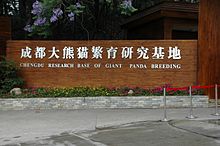
Previously a problem to reproduction, pandas lose their interest in mating once in captivity. This has led some scientists to try extreme methods such as showing pandas videos of mating pandas and giving male pandas Viagra. The primary reproduction method had been artificial insemination. Only recently have researchers begun to have success with captive breeding programs and have determined that pandas have comparable breeding to some populations of the American Black Bear, a thriving bear family. The current reproductive rate is considered one young every two years.
Pandas reach sexual maturity between the ages of 4 and 8, and may be reproductive until age 20. The mating season takes place between March and May, when a female goes into her estrous cycle which lasts for 2 or 3 days and only occurs once a year. During this time, two to five males can compete for one female; the male with the highest rank gets the female. When mating, the female is in a crouching, head-down position as the male mounts her from behind. Copulation time is short, ranging from thirty seconds to five minutes, but the male may mount her repeatedly to ensure successful fertilization. The whole gestation period ranges from 95 to 160 days. Baby pandas weigh only 90 to 130 grams (3.2 to 4.6 ounces), which is about 1/900 of the mother's weight. Usually, the female panda gives birth to one or two panda cubs. Since baby pandas are born very small and helpless, they need the mother's undivided attention, so she is able to care for only one of her cubs. She usually abandons one of her cubs, and it dies soon after birth. At this time, scientists do not know how the female chooses which cub to raise, and this is a topic of ongoing research. The father has no part in helping raise the cub.
When the cub is first born, it is pink, furless, and blind. It nurses from its mother's breast 6 to 14 times a day for up to 30 minutes at a time. For three to four hours, the mother may leave the den to feed, which leaves the panda cub defenseless. One to two weeks after birth, the cub's skin turns gray where its hair will eventually become black. A slight pink color may appear on the panda's fur, as a result of a chemical reaction between the fur and its mother's saliva. A month after birth, the color pattern of the cub's fur is fully developed. A cub's fur is very soft and coarsens with age. The cub begins to crawl at 75 to 90 days; mothers play with their cubs by rolling and wrestling with them. The cubs are able to eat small quantities of bamboo after six months, though mother's milk remains the primary food source for most of the first year. Giant Panda cubs weigh 45 kg (99.2 pounds) at one year, and live with their mothers until they are 18 months to two years old. The interval between births in the wild is generally two years.
Name
There is no conclusive source for the origin of the Anglicized name "panda." The closest candidate that has been accepted as the source originates in the Nepali word ponya, possibly referring to the adapted wrist bone. The Western world originally applied this name to the Red Panda. Until 1901, when it was erroneously stated that it was related to the Red Panda, the Giant Panda was known as "mottled bear" (Ailuropus melanoleucus) or "particolored bear."
Since the earliest collection of Chinese writings, the Chinese language has given the bear 20 different names of which the ones in use today are, 大熊貓 (dà xióng māo), literally "large bear cat," or just 熊貓 (xióng māo), "bear cat." The name may have been inspired by the Giant Panda's eyes which have pupils that are cat-like vertical slits unlike other bear species with round pupils. Just as likely, the Red Panda's name was transferred to its larger cousin and labeled in texts as "large bear cat."
Colloquially, locals from different provinces use the previously more physiologically accurate names such as 花熊 (hua xiong) "spotted bear" and 竹熊 (zhu xiong) "bamboo bear." In Taiwan, the modern name for panda is 貓熊 (māo xióng) "cat bear," where bear instead of cat is the base noun. Since this is grammatically correct, there is currently no effort to reverse the characters.
Pandas in zoos
A 2006 New York Times article outlined the economics of keeping pandas, which costs five times more than that of the next most expensive animal, an elephant. American zoos generally pay the Chinese government $1 million a year in fees, as part of a typical ten-year contract. San Diego's contract with China is the first to expire, in 2008. The last contract, in Memphis, ends in 2013.
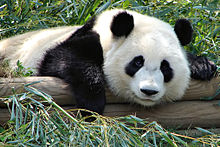
North America
As of 2007, five major North American zoos have Giant Pandas:
- Chapultepec Zoo, Mexico City - home of Xi Hua, born on June 25, 1985, Shuan Shuan, born on June 15, 1987, and Xin Xin, born on July 1, 1990 from Tohui (Tohui born on Chapultepec Zoo on July 21, 1981 and died on November 16, 1993), all females
- San Diego Zoo, San Diego, California - home of Bai Yun (F), Gao Gao (M), Su Lin (F), and Zhen Zhen (F), born in August 2007.
- US National Zoo, Washington, D.C. - home of Mei Xiang (F), Tian Tian (M), and their offspring Tai Shan (M)
- Zoo Atlanta, Atlanta, Georgia - home of Lun Lun (F), Yang Yang (M), Mei Lan (F), and a male cub born on August 30, 2008
- Memphis Zoo, Memphis, Tennessee - home of Ya Ya (F) and Le Le (M)

Notable North American-born pandas
- Hua Mei, born 1999 in the San Diego Zoo, returned to China 2004.
- Mei Sheng, born 2003 in the San Diego Zoo, returned to China 2007.
- Tai Shan, born July 9, 2005 at the National Zoo in Washington.
- Su Lin, born August 2, 2005 at the San Diego Zoo.
- Mei Lan, born September 6, 2006 at Zoo Atlanta.
- Zhen Zhen, born August 3, 2007 at the San Diego Zoo.

Europe
- Zoologischer Garten Berlin, Berlin, Germany — home of Bao Bao, age 27, the oldest male panda living in captivity; he has been in Berlin for 25 years and has never reproduced.
- Tiergarten Schönbrunn, Vienna, Austria — home to Yang Yang (F) and Long Hui (M), born in Wolong, China in 2000, and their new cub, Fu Long (M), born on August 23, 2007 at the zoo. The cub was the first to be born in Europe in 25 years.
- Zoo Aquarium, Madrid, Spain – home of Bing Xing (M) and Hua Zuiba (F). Arrived in Madrid on September 8, 2007.
- The Edinburgh Zoo is currently in negotiations with the Wolong Nature Preserve to obtain two Giant Pandas.
Asia
- Adventure World, Shirahama, Wakayama - Ei Mei (M), Mei Mei (F), Rau Hin (F), Ryu Hin and Syu Hin (male twins), and Kou Hin (M). In December 2006, twin cubs were born to Ei Mei and Mei Mei.
- Chengdu Research Base of Giant Panda Breeding, Chengdu, Sichuan, China - Home to a number of captive Giant Pandas, including 2 year old Xiong Bang (M), who just arrived from Japan. Twelve cubs were born here in 2006.
- China Conservation and Research Center for the Giant Panda at the Wolong National Nature Reserve, Sichuan, China - Seventeen cubs were born here in 2006.
- Chiang Mai Zoo, Chiang Mai, Thailand - home to Chuang Chuang (M) and Lin Hui (F).
- Ocean Park, Hong Kong - home to Jia Jia (F) and An An (M) since 1999. Two new pandas, Le Le (M) and Ying Ying (F), were added to Ocean Park on April 26, 2007.
- Oji Zoo, Kobe, Hyōgo - home of Kou Kou (M), Tan Tan (F)
Australia
- Adelaide Zoo, Adelaide - future home to Wangwang (M) and Funi (F). They will arrive in 2009.
Pandas in media
The first sequences of pandas in the wild were shot by Franz Camenzind for ABC in about 1982. They were bought by BBC Natural History Unit for their weekly magazine show Nature.
Recently, NHNZ has featured pandas in two documentaries. Panda Nursery (2006) featured China’s Wolong Nature Reserve in the mountains in Sichuan Province; forty Giant Pandas and a dedicated team of staff play a crucial role in ensuring the survival of the species. As part of the Reserve’s panda breeding program, a revolutionary new method of rearing twin cubs called ‘swap-raising’ has been developed. Each cub is raised by both its natural mother and one of the Reserve’s veterinarians, Wei Rongping, to increase the chances of both cubs surviving. Growing Up: Giant Panda (2003) featured Chengdu Giant Panda Center in south-west China as one of the best in the world. Yet with female pandas' short fertility cycles and low birth rates, raising the captive panda population is an uphill battle.
The panda Chow-Ling made an appearance in the movie Anchorman: The Legend of Ron Burgundy.
See also
Footnotes
- Template:IUCN2006 (Listed as Endangered )
- "Global Species Programme – Giant panda". World Wildlife Fund. 2007-11-14. Retrieved 2008-07-22.
- Bram, Leon (1986). Funk & Wagnalls New Encyclopedia Vol 20 (Hardcover ed.). Funk & Wagnalls Inc. pp. p. 119. ISBN 0-8343-0072-9.
{{cite book}}:|pages=has extra text (help); Cite has empty unknown parameter:|coauthors=(help) - ^ "Number of pandas successfully bred in China down from last year". Xinhua. 2007-11-08. Retrieved 2008-07-22.
- ^ "Hope for future of giant panda". BBC News. 2006-06-20. Retrieved 2007-02-14.
- Giant panda gives birth to giant cub
- ^ Warren, Lynne (2006-07). "Pandas, Inc". National Geographic. Retrieved 2008-04-10.
{{cite news}}: Check date values in:|date=(help) - "Concern grows for smallest bear". BBC News. 2007-11-12. Retrieved 2008-07-22.
- "Teenager hospitalized after panda attack in Chinese zoo". Fox News/Associated Press. 2007-10-23.
- "Animal Bytes: Giant Panda". San Francisco Zoo. Retrieved 2008-07-22.
- ^ Brown, Gary (1996). Great Bear Almanac. pp. pp.340. ISBN 1558214747.
{{cite book}}:|pages=has extra text (help) Cite error: The named reference "Bearalmanac" was defined multiple times with different content (see the help page). - ^ "Panda behavior & habitat". World Wildlife Federation China. Retrieved 2008-06-16. Cite error: The named reference "WWF" was defined multiple times with different content (see the help page).
- Paul Massicot (February 13, 2007). "Animal Info - Giant Panda". Animal Info. Retrieved 2008-06-17.
{{cite web}}: Check date values in:|date=(help) - DEBORAH SMITH BAILEY (Volume 35, No. January 1, 2004). "Understanding the giant panda". American Psychological Association.
{{cite web}}: Check date values in:|date=(help) - "Giant Panda". Smithsonian National Zoo. Retrieved 2008-07-17.
- ^ Ciochon, Russell L.; Eaves-Johnson, K. Lindsay (July 20, 2007), "Bamboozled! The Curious Natural History of the Giant Panda Family", Scitizen, retrieved 2008-07-22
{{citation}}: Check date values in:|date=(help) - Li, De-Zhu; Guo, Zhenhua; Stapleton, Chris (2007), "Fargesia dracocephala", in Wu, Z. Y.; Raven, P.H.; Hong, D.Y. (ed.), Flora of China, vol. 22, Beijing: Science Press; St. Louis: Missouri Botanical Garden Press, p. 93, retrieved 2007-10-06
{{citation}}: Check date values in:|accessdate=(help)CS1 maint: multiple names: authors list (link) - Li, De-Zhu; Guo, Zhenhua; Stapleton, Chris (2007), "Fargesia rufa", in Wu, Z. Y.; Raven, P.H.; Hong, D.Y. (ed.), Flora of China, vol. 22, Beijing: Science Press; St. Louis: Missouri Botanical Garden Press, p. 81, retrieved 2007-10-06
{{citation}}: Check date values in:|accessdate=(help)CS1 maint: multiple names: authors list (link) - O'Brien, Nash, Wildt, Bush & Benveniste, A molecular solution to the riddle of the giant panda's phylogeny, Nature 317, 140 - 144 (12 September 1985)
- Lindburg, Donald G.; Baragona, Karen (2004). Giant Pandas: Biology and Conservation. University of California Press. ISBN 0520238672.
{{cite book}}: CS1 maint: multiple names: authors list (link) - "Behind the News - Panda Granny". Australian Broadcasting Corporation. 2007-06-12. Retrieved 2008-07-22.
- "The Panda Lady: Ruth Harkness (Part 1)". Female explorers. Retrieved 2007-02-01.
{{cite web}}:|first=missing|last=(help); Unknown parameter|Last=ignored (|last=suggested) (help) - China's Panda Politics. Newsweek. October 15, 2007. Retrieved May 23, 2008.
- Pandas gain world heritage status BBC News
- Panda sanctuaries now World Heritage sites United Press International
- Prapanya, Narunart (2006-01-25). "'Panda porn' to encourage mating". CNN. Time Warner. Retrieved 2008-04-13.
- "Pandas unexcited by Viagra". BBC News. BBC. 2002-09-09. Retrieved 2008-04-13.
- "National Zoo's Giant Panda Undergoes Artificial Insemination". NBC. Associated Press. 2008-03-19. Retrieved 2008-04-13.
- "Giant Panda Reproduction" (PDF). Smithsonian National Zoological Park. Retrieved 2008-04-13.
- ^ Kleiman, Devra G. "Giant Panda Reproduction". Retrieved 2008-04-14.
- Alex Hawes and Matthew Huy (2001). "Whats in a Name? Giant Panda". Smithsonian National Zoo.
- Rita Putatunda (2008-02-15). "Facts on Pandas". Buzzle.com.
- "Discussion about the Chinese name for giant panda (in Chinese)".
- "New Giant Panda cub born at Zoo Atlanta". Zoo Atlanta.
- Lumpkin & Seidensticker 114
- San Diego Zoo Panda News
- Oleksyn, Veronika (2007-08-23). "Panda gives surprise birth in Austria". AP via Yahoo! News. Retrieved 2007-08-24.
- Japan-born cub returns to ancestral home
- ^ Panda news from China.org.cn
- "Hong Kong welcomes two giant pandas from China". Hong Kong Digest.
References
- AFP (via Discovery Channel) (2006, June 20). Panda Numbers Exceed Expectations.
- Associated Press (via CNN) (2006). Article link.
- Catton, Chris (1990). Pandas. Christopher Helm.
- Friends of the National Zoo (2006). Panda Cam: A Nation Watches Tai Shan the Panda Cub Grow. New York: Fireside Books.
- Goodman, Brenda (2006, February 12). Pandas Eat Up Much of Zoos' Budgets. The New York Times.
- Lumpkin, Susan; Seidensticker, John (2007). Giant Pandas. London: Collins. ISBN 0-06-120578-8.
{{cite book}}: CS1 maint: multiple names: authors list (link) - Panda Facts At a Glance (N.d.). www.wwfchina.org. WWF China.
- Ryder, Joanne (2001). Little panda: The World Welcomes Hua Mei at the San Diego Zoo. New York: Simon & Schuster.
- Schaller, George B. (1993). The Last Panda. Chicago. University of Chicago Press.
- Wan, Q.-H., H. Wu, and S.-G. Fang (2005). "A New Subspecies of Giant Panda (Ailuropoda melanoleuca) from Shaanxi, China. Journal of Mammalogy 86: 397–402.
- Warren, Lynne (2006, July). "Panda, Inc." National Geographic. (About Mei Xiang, Tai Shan and the Wolong Panda Research Facility in Chengdu China).
External links
- GLOBIO's Glossopedia; Giant Panda - Children's science and nature encyclopedia
- Panda Pioneer: the release of the first captive-bred panda 'Xiang Xiang' in 2006
- WWF - environmental conservation organization
- Giant Panda Species Survival Plan
- Pandas International - panda conservation group
- Smithsonian National Zoo Live Panda Cams - (Baby Panda Tai Shan and his mother Mei Xiang)
- Photos of Giant Pandas in Beijing Zoo
- Information from Animal Diversity
- A selection of the best panda videos available online
- Wolong Panda Club
- Watch Pandas live online
- NPR News 2007/08/20 - Panda Romance Stems From Bamboo